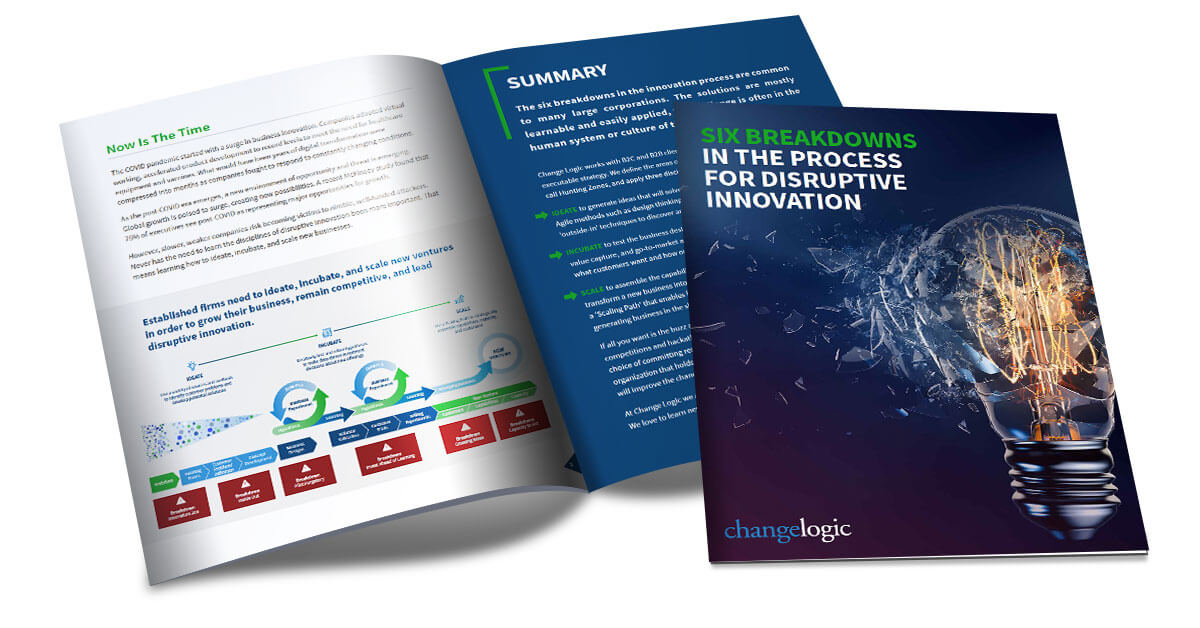This article is reprinted with permission from Fast Company
Whenever markets get turned upside down, as they have been during the pandemic, it creates opportunities to reinvent the rules for how business is done. This is good news if you are ready to innovate, but bad news if you are hoping everything will just return to normal. Now is when corporations need to step up the rate of innovation and capitalize on new opportunities.
Unfortunately, many companies struggle to create radically new businesses. Investing in unproven ideas is hard for managers who are used to driving quarterly profits in relatively stable industries. A McKinsey study on post-COVID growth found that nearly 75% of managers see the opportunity, but fewer than 30% feel they have the expertise, resources, and commitment to capture growth.
Conventional wisdom says that corporations cannot do radical innovation. Instead, the perception is that innovation is a game for entrepreneurs with backing from venture capital. Although corporations have greater financial and technological assets, the view persists that they lack the entrepreneurial spirit to back new ventures. Corporate managers with good ideas are often advised to become entrepreneurs rather than waste time slogging through big-company bureaucracy looking for approval.
While there is a lot of truth in that assessment, conventions are for breaking, and a new breed of corporate managers are leading the way.
I have been working for over 20 years to help companies beat the odds and build disruptive new businesses. During that time, I have observed some consistent patterns that get in the way. I call them the six breakdowns in the quest for disruptive innovation. These are the places where organizations struggle most, and that can be prevented to increase the odds of success. Knowing what they are can help managers take action now to get ahead of the curve of industry disruption.
INNOVATION BREAKDOWN 1: THE IDEA ZOO
Many firms start by trying to create a “culture of innovation” — they want to empower employees to put their best ideas into action. That works for incremental improvements, but use it to create something radically new and you can soon end up in an innovation zoo. Lots of ideas, many small, underfunded projects, and a lack of strategic clarity.
You can fix this by establishing a bold ambition and putting some boundaries around ideation. At the tech firm Nvidia, Jensen Huang wanted to put the company at the center of the AI revolution. He defined five end markets that he wanted to dominate (like deep computing and autonomous driving). Ten years later, the firm is riding high with a stock price that has grown 2000% in five years.
INNOVATION BREAKDOWN 2: INSIDE OUT
Great firms are based on deep expertise. As firms age, the experts (engineers, scientists, actuaries, etc.) get more powerful. They know the technical possibilities of their products, but that doesn’t guarantee market success. Customers behave in ways experts don’t expect, and this leads to an unnecessarily high cost of failure.
Focus on knowing what customer problem you are solving, because that can transform innovation outcomes. Bosch has increased returns on new innovation projects by forcing its engineers through a rigorous customer validation process.
INNOVATION BREAKDOWN 3: PILOT PURGATORY
Thanks to innovation all-stars like Steve Blank, we are learning to do pilots and experiments. However, these small-scale projects can easily get lost in the day-to-day grind of growing profits. They hang around like zombies waiting to be killed, but so often it never happens.
Innovators need to be change leaders too. Bondili at Deloitte set out to build his crowdsourcing business Pixel by analyzing the internal ecosystem. He asked himself, “What sponsors do I need onboard? Can I get more than one source of funding so that I always have multiple points of failure?”
INNOVATION BREAKDOWN 4: INVESTING AHEAD OF LEARNING
Experimentation is great, but running many small experiments to get a few big wins is painstaking. Executives say they want a ‘fail fast’ culture, but failure is not the goal. What matters is our capacity to learn. That takes some patience.
One way to do this is to learn to adopt new metrics to evaluate the success of non-traditional businesses. Show senior managers how innovation is making progress against its goals and what the path is to success. You’ll find that will relieve some of the performance anxiety.
INNOVATION BREAKDOWN 5: CROSSING WIRES
An axiom to live by is that the core will always beat out the explore in any business. Pressure to deliver short-term profits is tough to resist. It is the logic of an operating business to drive for profits, not spend time investing in uncertain new ventures.
Ambidextrous Organizations split out the explore units from the core to create more autonomy to operate. UNIQA Insurance Group in Vienna has created ‘SanusX’ as a safe place to build new ventures in the healthcare market.
INNOVATION BREAKDOWN 6: LACKING CAPACITY TO ACT
No matter the evidence and how carefully you work on a new venture, the leaders who need to invest are still human beings. Under pressure, some stand at the precipice and do not act. The fear of losing what they have is greater than their confidence in what they might gain.
Analog Devices CEO Vincent Roche (a client of Change Logic) runs one of the most profitable corporations in the S&P 500. He deliberately separates his commitment to sustaining this business from the one that he has to building new engines of growth. His both/and style of leadership helps him navigate the tradeoffs that leaders of disruptive innovation have to make every day.
These are six big issues. I have only scratched the surface of the causes and, more importantly, the solutions managers can pursue to get their innovation initiatives on track. I go into this topic in more detail in my recent whitepaper “The 6 Breakdowns of Disruptive Innovation.”
[av_button label=’Download Now’ icon_select=’no’ icon=’ue800′ font=’entypo-fontello’ link=’resource,5765′ link_target=” size=’medium’ position=’center’ label_display=” title_attr=” color_options=” color=’theme-color’ custom_bg=’#444444′ custom_font=’#ffffff’ btn_color_bg=’theme-color’ btn_custom_bg=’#444444′ btn_color_bg_hover=’theme-color-highlight’ btn_custom_bg_hover=’#444444′ btn_color_font=’theme-color’ btn_custom_font=’#ffffff’ id=” custom_class=” av_uid=’av-2nvrtu’ admin_preview_bg=”]
The next 12 months coming out of the pandemic are critical for businesses and innovation. Nobody can afford a breakdown — especially not one that they could have seen coming.

